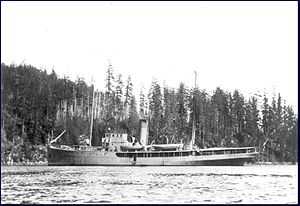HMCS Galiano
 HMCS Galiano | |
| Career (Canada) | |
|---|---|
| Name: | CGS Galiano |
| Builder: | Dublin Dockyard |
| Laid down: | 1913 |
| Launched: | 1913 |
| Acquired: | 1914, as CGS Galiano |
| Commissioned: | 15 December 1917, as HMCS Galiano |
| Struck: | 1918 |
| Fate: | Foundered 30 October 1918 |
| General characteristics | |
| Displacement: | 393 tons |
| Length: | 162 ft (49 m) |
| Beam: | 27 ft (8.2 m) |
| Draught: | 13 ft (4.0 m) |
| Speed: | 11 knots (20 km/h) |
| Complement: | 33 |
| Armament: | 1 6-pounder(?) |
HMCS Galiano was a Canadian government fisheries patrol vessel pressed into service with the Royal Canadian Navy in 1917. Galiano disappeared in a storm in October 1918, making her Canada's only warship lost during the First World War.
Origins and Military Service
Built by the Dublin Dockyard in Dublin, Ireland, in 1913, Galiano was a steel-hulled, single-screw vessel fitted with a powerful search light, as well as electrical lighting for the whole ship, and was the sister ship of the CGS Malaspina. Galiano was named after commander Dionisio Alcalá Galiano of the Spanish navy, who had explored the Strait of Georgia in 1792, and for whom Galiano Island was named.
Galiano arrived in Esquimalt, British Columbia on 21 February 1914 to start her duties in the fisheries protection service as a patrol boat. Although not formally commissioned as naval vessels until 1917, Galiano and her sister ship Malaspina mixed civil duties with naval patrol and examination work, including minesweeping training and trials, for much of the war. Following Galiano's transfer to the Royal Canadian Navy, she was commanded by Lieutenant Robert May Pope, RNCVR.
Loss
In late October, 1918, the Galiano, just returned from the Queen Charlotte Islands (now Haida Gwaii) and, in need of some repair, was sent with supplies to the light house at Triangle Island off Cape Scott at the northwestern tip of Vancouver Island. A number of her regular crew were unable to make the trip due to illness as the 1918 flu pandemic had reached her base at Esquimalt. She set out towards the Queen Charlotte Islands from Triangle Island at 5 pm on October 29, 1918. When she made her only distress call at 3 am the next morning, she was estimated to be within visual range of the light at Cape St. James 95 miles from Triangle Island. She was never heard from again and went down with the loss of all hands. At the time of her distress call, there were heavy seas running at her location in Queen Charlotte Sound. She was lost just days after the SS Princess Sophia ran aground on Vanderbilt Reef, near Skagway, Alaska also in heavy weather.[1]:64
The Naval Memorial in Ross Bay Cemetery, Vancouver Island, British Columbia bears the names of 39 officers and men who were lost at sea. Of these, 36 were from HMCS Galiano, which sunk on 30 October 1918.[2]
References
- ↑ James, Rick (2011), West Coast Wrecks & Other Maritime Tales, Raincoast Chronicles 21, Vancouver: Harbour Publishing, ISBN 978-1-55017-545-5
- ↑ http://www.thecanadianencyclopedia.com/index.cfm?PgNm=TCE&Params=A1ARTA0009128 Canadian Encyclopedia Monuments, World Wars I and II
See also
- Canada's only lost Warship
- HMCS Galiano
- Converted civilian vessels
- Canadian Navy Heritage Project: Ship Technical Information
- Canadian Navy Heritage Project: Photo Archive